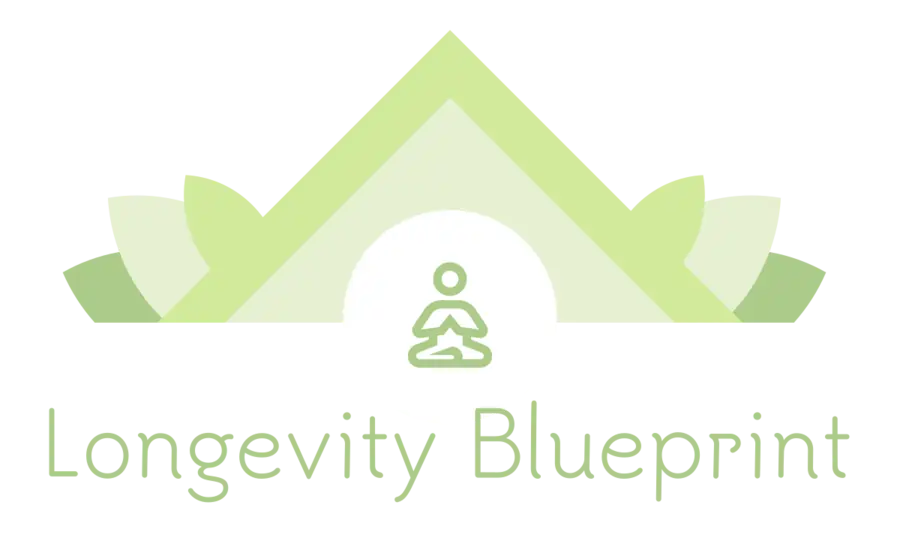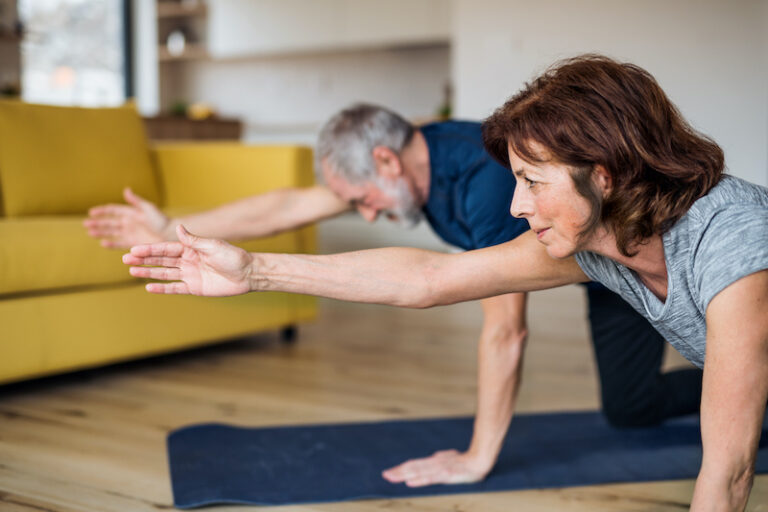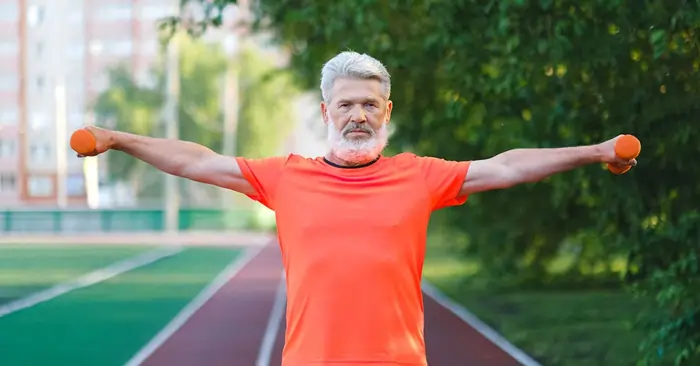Powerful Workout Routines for Women Over 40: Empowered 10-Minute Daily Plan
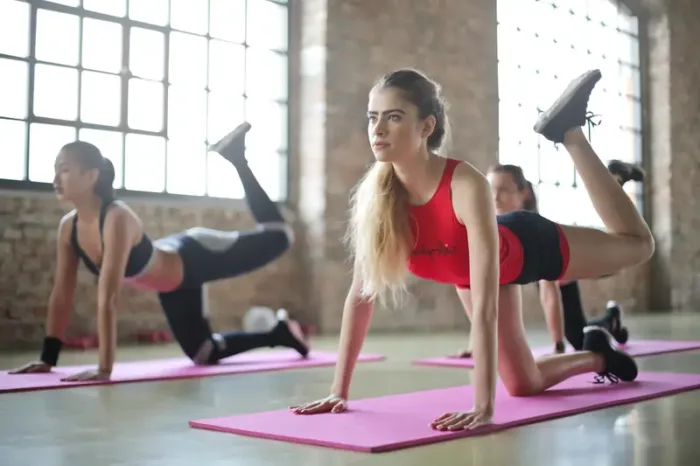
This biological reality means the exercises that worked in your 20s and 30s might not be the best workout routines for women over 40. However, this doesn’t mean you need to spend hours at the gym or push yourself through grueling workouts to stay fit and strong.
Did you know that women lose about 3-8% of their muscle mass each decade after turning 40?
In fact, short, targeted workouts can be more effective than lengthy exercise sessions, especially as your body’s needs change. Fortunately, maintaining strength, flexibility, and overall fitness after 40 is entirely possible with the right approach.
This trainer-designed 10-minute daily workout routine specifically addresses the unique fitness needs of women over 40, focusing on strength, mobility, and bone health. Let’s explore how you can stay fit and strong with exercises that work with your body, not against it, including effective plank exercises and other key movements for getting in shape at 40.
📺 **Watch Now: Workout Routines for Women Over 40: A Trainer’s 10-Minute Daily Plan**
Workout Routines for Women Over 40: Changes over 40
The midlife transition brings profound physiological changes that require a fresh approach to fitness. As women enter their 40s and beyond, understanding these changes becomes essential for creating effective exercise routines and getting fit at 40.
Physical changes in midlife women
Midlife triggers significant transformations in women’s bodies that directly impact physical fitness. After age 40, women experience a natural decline in muscle mass, which decreases by 3-8% per decade after age 30 and accelerates to 5-10% per decade after 50 [1]. This reduction in muscle mass and strength increases the risk of falls, fractures, and physical disability.
The menopausal transition, typically occurring between ages 45-55, marks a pivotal shift in women’s physiology. During this period, declining estrogen levels lead to substantial changes in body composition – increasing fat mass while simultaneously decreasing lean muscle mass and bone mineral density [1].
Research shows that nearly one in five women aged 40-55 reports some limitations in physical functioning, with this percentage climbing to almost 50% among women aged 56-66 [2]. Additionally, about half of women reduce their regular exercise during middle age, further compromising their metabolic health [2].
Benefits of consistent short workouts
Fortunately, consistent exercise—even in short durations—can significantly counteract these age-related changes. Women who meet physical activity guidelines by age 55 score approximately 3 points higher on physical health composite scores than those who don’t exercise regularly [3].
Contrary to common belief, you don’t need lengthy workout sessions to maintain fitness over 40. Studies indicate that as little as 5-6 strength training sets per muscle group weekly can produce meaningful adaptations for beginners [1]. Furthermore, even 4-minute high-intensity workout routines can improve cardiometabolic health and VO2 max [4].
Brief, focused workouts offer practical advantages for busy midlife women. Since consistency matters more than duration, shorter sessions make regular exercise more sustainable. As one fitness expert notes, “The all-or-nothing mindset that a workout needs to be of a certain length or intensity to count is actually a huge barrier for success” [5].
Setting realistic fitness goals
Creating achievable fitness goals becomes particularly important for women over 40. Rather than aiming for dramatic transformations, focus on gradual progress with specific, measurable objectives [6].
When establishing fitness goals, consider:
Specificity – Instead of general goals like “get in shape,” aim for concrete targets such as “do modified push-ups for 30 seconds without stopping”
Personal relevance – Choose goals meaningful to you personally, not based on others’ expectations
Appropriate timeframes – Allow sufficient time for realistic progress, particularly as recovery may take longer after 40
Mini-goals – Break larger objectives into smaller, achievable steps to maintain motivation
Furthermore, tracking progress in multiple ways beyond the scale helps sustain motivation. Consider measurements like energy levels, sleep quality, and how clothes fit rather than focusing solely on weight [6].
The midlife period represents a critical window for establishing healthy patterns. Although many women reduce their activity during this stage due to competing demands at home and work [2], this life phase actually offers a unique opportunity to implement positive changes that will impact long-term health and independence [2].
The 10-Minute Workout Routines for Full-Body Warm-Up
Starting your workout properly can make all the difference in both your performance and safety, particularly as we age. A thorough warm-up prepares your muscles, increases blood flow, and improves flexibility—all crucial elements for women over 40 engaging in strength training over 40.
Dynamic stretching sequence
Unlike static stretching where you hold positions, dynamic stretching involves active movements that prepare your body for exercise. Research indicates dynamic stretches are superior to static stretches as part of a warm-up, with studies showing just 10 minutes of dynamic warm-up can improve performance in multiple physical tests [7].
For women over 40, a proper dynamic stretching sequence should begin with:
Marching in place (3 minutes) – Start by marching on the spot, then forward and backward. Pump your arms in rhythm with your steps, keeping elbows bent and fists relaxed [8].
Heel digs (1 minute) – Place alternate heels to the front with the front foot pointing up. Aim for 60 heel digs in 60 seconds, maintaining a slight bend in the supporting leg [8].
Knee lifts (30 seconds) – Stand tall and bring alternate knees up to touch the opposite hand. Keep your abs tight and back straight while maintaining a slight bend in the supporting leg. Aim for 30 knee lifts [8].
Shoulder rolls (2 sets) – While marching in place, roll your shoulders forward 5 times and backward 5 times, keeping your arms hanging loosely at your sides [8].
Lateral lunges – These work multiple muscles in your legs, inner thighs, and core, making them excellent all-over lower body stretches [9].
Instead of holding static stretches before your workout (which can actually decrease muscle performance), focus on movements that mirror the exercises you’ll be doing in your routine [9]. This rehearsal quality helps prepare your muscles for optimal performance while reducing injury risk.
Joint mobility exercises
Joint mobility becomes increasingly important after 40, as joint stiffness and reduced range of motion are common age-related changes. According to health experts, good mobility contributes to better balance, fewer falls, and improved performance during everyday activities [10].
For comprehensive joint preparation, include these mobility exercises:
Ankle mobility – Rock slowly from toes to heels and back again for 10 repetitions. This promotes flexibility in the ankles, which contributes to better balance [10].
Hip mobility – The hips are workhorses of our bodies yet often become restricted from prolonged sitting. Try walking lunges or gentle hip circles to open the hip joints. The “90/90 hip switch” is especially effective for women over 40 [11].
Thoracic spine mobility – The spine between your shoulder blades needs attention to prevent upper back pain and poor posture. Thoracic rotations help open this area—lie on your side with knees bent, then rotate your upper body and arm in an opening motion [10].
Shoulder mobility – Shoulder pass-throughs using a broomstick help counteract the forward slump that develops from desk work. This movement improves rotator cuff mobility and chest flexibility [10].
Moreover, a properly designed warm-up accomplishes multiple goals: increasing blood flow, loosening joints, waking up muscles, and correcting movement inefficiencies [12]. Consequently, the right 10-minute warm-up can reduce injury risk by up to 30% according to recent research [7].
Remember, consistency is key with mobility work. Even 5-10 minutes daily yields noticeable improvements [11], making this an essential component of any fitness routine for women over 40.
Core and Posture Strengthening Moves
A strong core forms the foundation of overall fitness for women over 40, supporting not only everyday movements but also protecting against common midlife issues like back pain and postural decline. Incorporating effective plank exercises into your routine can significantly enhance core strength and stability.
Modified planks for back health
The plank is unquestionably one of the most effective core exercises, activating multiple muscle groups simultaneously. Nevertheless, many traditional planks can strain the lower back, particularly for women experiencing age-related changes.
Modified planks offer the same core-strengthening benefits while protecting your spine. The forearm plank activates all core muscles at once without requiring extra movements that might cause stress or injury [13]. If you’re new to planks or haven’t done them recently, start with knee planks:
Begin on your hands and knees, aligning shoulders directly over elbows
Keep your back straight, creating a modified “plank position”
Tighten your abdominal muscles while maintaining proper alignment
Hold for 10-15 seconds initially, gradually building to 30 seconds
As you progress, aim for 3 sets of 10-15 second holds, eventually working up to 30-second holds [14]. Remember that proper plank form is crucial—avoid arching your back or dropping your head, as these mistakes defeat the exercise’s purpose and may cause injury [15].
For those seeking a plank alternative, the high plank position can be an excellent option. This variation engages the arms and shoulders more intensely while still providing core benefits. As you become more comfortable with planks, you can explore various types of planks, such as the reverse plank, which targets the posterior chain and helps improve posture.
Pelvic floor engagement techniques
For women over 40, pelvic floor strength becomes increasingly important yet is often overlooked. These muscles support your bladder, uterus, and bowel, with weakness potentially leading to issues like urinary leakage.
Kegel exercises strengthen these essential muscles. To perform them correctly:
Identify the right muscles by imagining you’re stopping the flow of urine
Tighten these muscles, feeling a slight pulling sensation in your rectum and vagina
Hold for 3 seconds, then relax for 3 seconds
Work toward 10-15 repetitions per set, aiming for 3 sets daily [16]
Certainly, coordinate your pelvic floor engagement with other exercises. During planks or standing movements, focus on drawing up and tightening these muscles as you exhale. This integration helps make pelvic floor activation a natural part of your routine [17].
Standing core exercises
Standing core exercises offer unique advantages for women over 40, combining functional strength with practical everyday movements. Unlike floor exercises, standing core work engages multiple muscle groups simultaneously while improving balance and stability.
Standing exercises create greater muscle activation as you work against gravity to maintain stability [2]. They’re also gentler on the body, making them ideal if you have difficulty getting up and down from the floor or are recovering from injury [18].
Effective standing core exercises include:
Standing bird dog: Extend opposite arm and leg while maintaining balance, strengthening your back and abdominals simultaneously
Wood chops: Hold light weights or just use body weight, rotating from high to low in a diagonal pattern
Standing side bends: With or without weights, bend to each side while keeping hips stable
These movements not only strengthen your core but also improve posture by engaging the muscles that support proper alignment [19]. Furthermore, standing exercises promote better breathing patterns and teach your body to maintain core engagement during everyday activities [2].
By incorporating these three types of core-strengthening approaches into your routine, including various plank exercises and their benefits, you’ll build stability, improve posture, and enhance overall functional strength—all crucial benefits among the best exercises for women over 40.
Lower Body Exercises for Bone Density
As estrogen levels decline after 40, bone density naturally decreases, making strength training no longer optional but essential for women’s health. Strength training specifically targeting the lower body helps maintain bone density and reduces fracture risk, which becomes increasingly important with age [20].
Modified squats and lunges
Traditional squats and lunges rank among the most effective exercises for building lower body strength, yet they often need modification for women over 40 to protect joints while delivering maximum benefit.
For chair squats, position yourself in front of a sturdy chair:
Stand with feet hip-width apart
Lower your body as if sitting down, keeping knees behind toes
Hover just above the seat (or lightly touch it)
Rise back up by pressing through your heels [21]
For reverse lunges, step backward instead of forward to reduce knee strain. This variation puts less stress on joints while still effectively targeting glutes, quadriceps, and hamstrings [22].
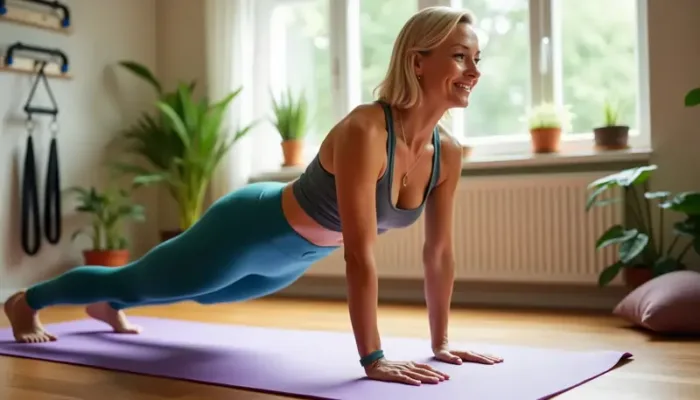
Low-impact strength builders
Glute bridges strengthen the entire posterior chain without jarring joints. Lie on your back with knees bent, feet flat. Squeeze glutes and lift hips toward the ceiling, creating a straight line from shoulders to knees [20].
Side-lying leg raises effectively strengthen hip abductors and promote stability. These muscles are vital for preventing falls and maintaining proper hip alignment [23].
Importantly, these exercises should be performed every other day at most, as the leg muscles—being the largest in the body—require adequate recovery time [5].
Balance-enhancing movements
Single-leg exercises become increasingly important after 40. The single-leg stance test actually serves as an indicator of fall risk among older adults [23].
Try the single-leg deadlift: Balance on one leg, hinge forward from the hips while extending the opposite leg behind you. This simultaneously challenges balance while strengthening hamstrings and glutes [24].
Tandem stance (heel-to-toe position) mimics walking on a balance beam. Hold for 30 seconds, gradually progressing to walking in this position to improve coordination [4].
First thing to remember is consistency matters more than intensity—aim for 2-3 weekly lower body sessions to build bone density effectively [25].
Upper Body Toning Without Equipment
Toning your upper body becomes increasingly vital after 40, yet many women avoid these exercises due to concerns about equipment or developing “bulky” muscles. Fortunately, effective upper body strengthening can be achieved using just your body weight, making it an excellent addition to your fitness over 40 routine.
Wall push-ups progression
Wall push-ups provide an excellent foundation for upper body strength, targeting the chest, shoulders, and triceps—areas that often lose tone with age. This exercise puts less stress on the wrists, elbows, and shoulders compared to standard floor push-ups, making it ideal for women over 40.
To perform wall push-ups correctly:
Stand facing a wall with feet hip-width apart, about arm’s length away
Place your palms flat against the wall at shoulder height
Bend your elbows to bring your chest toward the wall
Push back to the starting position while keeping your body in a straight line
As you grow stronger, increase the challenge by moving your feet farther from the wall. This progression gradually builds upper body strength that transfers to daily activities like carrying groceries or lifting objects.
Arm circles and extensions
Arm circles effectively target the shoulders while improving range of motion. Begin with arms extended to the sides at shoulder height, making small circles forward for 30 seconds, then reverse direction. Keep your shoulder blades squeezed together to activate upper back muscles that combat the “bat wings” appearance common after 40.
For tricep extensions, position your arms with elbows at 90 degrees and tap your shoulders while maintaining elbow height. This simple movement strengthens the triceps while engaging the core for stability.
Posture correction exercises
Poor posture affects not only appearance but also contributes to pain and reduced function. Posture-specific exercises primarily target the muscles of the spine, shoulders, and upper back.
Shoulder rolls help release tension while improving shoulder mobility. Roll shoulders forward five times, then backward five times while standing tall.
Chest openers counteract the forward slump that develops from desk work. Stand with arms at your sides, then squeeze your shoulder blades together while lifting your chest slightly. Hold briefly, then release.
Above all, remember that consistent practice of these simple movements yields remarkable results over time. Incorporate these exercises into your daily routine—even while waiting for coffee to brew or during short breaks—to maintain upper body strength and improve posture essentially without disrupting your day.
Conclusion
Staying fit after 40 requires a smart approach rather than intense workouts. This 10-minute daily routine addresses key areas that matter most for midlife women – core strength, bone density, and overall mobility. It incorporates effective plank exercises, balance exercises, and other bodyweight exercises tailored for getting in shape at 40.
Remember that consistency trumps intensity when building strength and maintaining fitness after 40. Small, regular efforts through modified exercises protect your joints while delivering meaningful results. These targeted movements work with your changing body, not against it.
Start where you are comfortable, gradually increase intensity, and celebrate small improvements along the way. Your body will respond positively to these age-appropriate exercises, helping you maintain strength, flexibility, and independence for years to come.
Consider incorporating other forms of exercise like yoga or HIIT workouts to further enhance your fitness over 40. These varied approaches can improve cardiovascular fitness, aid in weight management, and contribute to overall functional fitness.
By focusing on a combination of strength training over 40, plank workouts, and other targeted exercises, you’re not just working out—you’re investing in your long-term health and well-being. Remember, what do planks do? They build core strength, improve posture, and enhance overall stability—all crucial benefits for women over 40.
Whether you’re just getting started with planks for beginners or exploring advanced plank variations, the key is to maintain proper form and consistency. The benefits of planks for females extend beyond just core strength, contributing to improved posture, reduced back pain, and enhanced overall functional fitness.
Embrace this journey of fitness over 40 with patience and persistence. Your body will thank you for the care and attention you’re giving it through these tailored exercises and thoughtful approach to staying active and healthy.
FAQs
Why is exercise different for women over 40?
Women over 40 experience muscle mass decline and hormonal changes, requiring targeted exercises for strength, mobility, and bone health.
What are the benefits of short, consistent workouts?
Short, consistent workouts improve physical health, are sustainable, and counteract age-related changes, making them ideal for busy midlife women.
How should women over 40 set fitness goals?
Set specific, personally relevant, and time-appropriate goals. Break larger objectives into mini-goals and track progress beyond just weight.
What exercises are included in a 10-minute warm-up for women over 40?
A 10-minute warm-up includes dynamic stretches like marching, heel digs, knee lifts, shoulder rolls, and lateral lunges to prepare muscles and joints.
References
[1] – https://bmcwomenshealth.biomedcentral.com/articles/10.1186/s12905-023-02671-y
[2] – https://www.onepeloton.com/blog/standing-core-exercises/
[3] – https://www.medicalnewstoday.com/articles/women-in-their-40s-and-50s-are-urged-to-stay-active-to-improve-their-quality-of-life
[4] – https://www.coretotalwellness.com/blog/balance-and-stability-exercises-during-menopause
[5] – https://www.today.com/health/diet-fitness/best-leg-exercises-rcna21979
[6] – https://www.betterhealth.vic.gov.au/health/healthyliving/physical-activity-setting-yourself-goals
[7] – https://www.womenshealthmag.com/fitness/g26554730/best-warm-up-exercises/
[8] – https://www.nhs.uk/live-well/exercise/how-to-warm-up-before-exercising/
[9] – https://www.prevention.com/fitness/a20474821/5-stretches-you-should-do-if-over-40/
[10] – https://www.healthline.com/health/fitness-exercise/joint-mobility-exercises
[11] – https://www.womenshealthmag.com/fitness/a40059106/mobility-exercises/
[12] – https://pittsburghnorthfitness.com/maximize-your-workout-the-essential-over-40-warm-up-guide/
[13] – https://www.health.harvard.edu/blog/straight-talk-on-planking-2019111318304
[14] – https://www.health.harvard.edu/staying-healthy/the-best-core-exercises-for-older-adults
[15] – https://www.today.com/health/diet-fitness/plank-exercise-rcna24413
[16] – https://www.mayoclinic.org/healthy-lifestyle/womens-health/in-depth/kegel-exercises/art-20045283
[17] – https://longevity.stanford.edu/lifestyle/2025/03/06/pelvic-floor-health/
[18] – https://faithfulworkouts.com/best-standing-ab-exercises-for-women-over-40/
[19] – https://www.womenshealthmag.com/fitness/g62333427/posture-improving-exercises/
[20] – https://www.verywellfit.com/must-do-strength-training-women-over-50-3498202
[21] – https://northtexasclinicandrehab.com/low-impact-strength-training/
[22] – https://www.healthline.com/health/exercise-fitness/lunges-benefits
[23] – https://www.eatthis.com/leg-exercises-for-women-after-50/
[24] – https://www.nourishmovelove.com/strength-training-leg-day-workout/
[25] – https://theros.org.uk/information-and-support/bone-health/exercise-for-bones/
